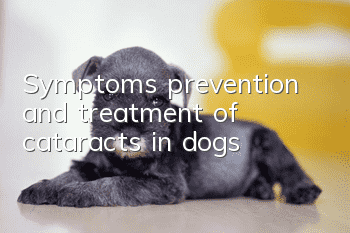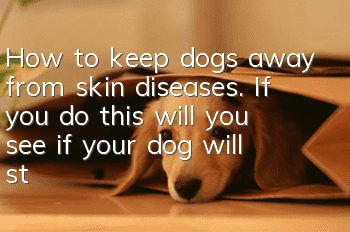Symptoms, prevention and treatment of cataracts in dogs

"Canine cataract" refers to the opacity of the dog's lens or anterior lens capsule, which causes the dog's vision to be reduced or lost due to obstruction of the visual pathway. If a dog has cataracts, what symptoms will the dog have, how to diagnose it, and how to treat it?
American Cocker Spaniel
1. Causes of cataracts in dogs:
1. Congenital cataract in dogs: It begins in the embryonic period. Due to abnormal development of the lens and its capsule in the mother's body, it manifests as cataracts after birth.
2. Traumatic cataract in dogs: Due to various mechanical injuries (such as corneal penetration), the nutrition of the lens and its lens capsule is impaired.
3. Secondary cataract in dogs: secondary to other eye diseases and systemic diseases, such as iritis, uveitis, diabetes, etc.
4. Canine senile cataract: It is a degenerative change of the lens, mainly seen in older dogs aged 8-12 years.
2. Key points for diagnosis of canine cataract:
1. Clinical symptoms
At present, the main basis for diagnosing canine cataract in China is the clinical symptoms of the disease. When a dog shows symptoms of vision loss, such as staggering, often bumping into objects when walking in an unfamiliar environment, unable to see thrown balls, and strabismus. , easily frightened, extremely sensitive to surrounding sounds, prone to aggression towards strangers, and turning a blind eye to danger, etc., you can suspect cataracts.
2. Laboratory examination
After dilating the pupils with 10 g/L tropicamide, the assistant will take the dog into a dark room and keep it safe, and then the veterinarian will examine it with a slit lamp or ophthalmoscope. If the laboratory does not have equipment such as an ophthalmoscope, you can also use a small flashlight and a magnifying glass to form a simple device for inspection [5].
Thorough examination, if there are dot-like shadows around the lens or at the posterior pole, it can be suspected.
Slit lamp microscopy shows that there is punctate opacity around the lens or at the posterior pole, but the cortex is still transparent; or if water scar-like changes appear at the posterior pole of the lens, it can be judged as a cataract.
3. Ultrasound examination
The use of ophthalmic ultrasound equipment can clearly distinguish various structures in the eye, and the image is clear and the effect is very good. Generally, a small ultrasound probe of 7.5 MHz or above is required to detect cataracts. For large dogs, a 5 MHz probe is required to examine the structures behind the eyeball. If clearer images are required, a higher frequency probe is required. When a dog suffers from eye pain orWhen the animal is extremely uncooperative, sedation or local anesthesia or even general anesthesia is required. In a normal canine lens, only the anterior capsule and posterior capsule of the lens have obvious echoes on the B-ultrasound. When there is an obvious weak or strong echo in the peripheral part of the lens, the dog can be judged to have cataracts.
3. Treatment of cataracts in dogs
Canine cataract is a disease that cannot be cured by any medicine. The color change of the crystal is like the process of a hard-boiled egg, from egg white to albumen. The only way to restore vision is to remove the cloudy lens surgically.
Any cataract that develops rapidly can cause eye irritation before surgery. Uveitis (inflammation inside the eye) usually occurs due to abnormalities in the lens. Regardless of whether cataract surgery is performed, uveitis requires timely treatment, otherwise it will cause other eye problems.
Cataract surgery in dogs is the same as cataract surgery in humans. We call it phacoemulsification surgery. During the surgery, we will first dilate the pupils, and then make a small opening at the edge of the cornea. Inside the eye, the lens actually stays in a pocket, which we call the lens capsule. We tear a small hole in the capsule. , we insert the ultrasound probe into it and break the crystal into pieces, but we cannot break the capsular bag. Once the lens has been aspirated, we will place an intraocular lens. The intraocular lens has two loops that support it within the capsular bag. Finally, the corneal incision is sutured.
4. Postoperative care methods for canine cataracts
Postoperative care for canine cataracts is very important. If postoperative care is ignored, it may have adverse effects on the originally successful surgery. Therefore, at this stage, the owner must take good care of the sick dog to prevent the dog from being overly excited. It is important to regularly give the dog eye drops, wear an Elizabethan ring, and conduct regular reviews.
Drug treatment: Use steroid anti-inflammatory drugs to accelerate the healing of the wound suture, but when corneal ulcer occurs, steroid drugs should be stopped immediately until the ulcer heals; broad-spectrum antibiotics should be used after surgery to prevent bacterial infection; use Topical mydriatic drugs (such as atropine, tropicamide) treat post-operative uveitis, accelerate the outflow of aqueous humor, and reduce eyeball swelling.
Due to insufficient understanding and attention to canine cataracts in the veterinary field, most sick dogs fail to receive timely treatment and become blind. I hope the materials provided in this article can help you.
- The dog doesn't sleep at night and walks back and forth. What's the reason why the dog doesn't sleep at night?
- How to treat urinary tract stones in dogs? Dogs may need surgery!
- What should I do if my dog has no milk? The owner should check quickly and don’t let the puppies starve to death.
- Dog’s anal gland odor, please note that this is a sign of your dog’s health!
- What are the symptoms of dog pain? How to detect dog pain early
- How to make your dog like to eat dog food Four ways to make your dog fall in love with dog food
- Can dogs digest peach pits if they eat them? Can dogs digest peach pits if they accidentally eat them?
- How to protect your dog’s food? Teach you tips on training your dog
- Why do dogs defecate everywhere? How can dogs stop defecating everywhere?
- What should I do if my dog has lupus? Immune system diseases should not be underestimated



